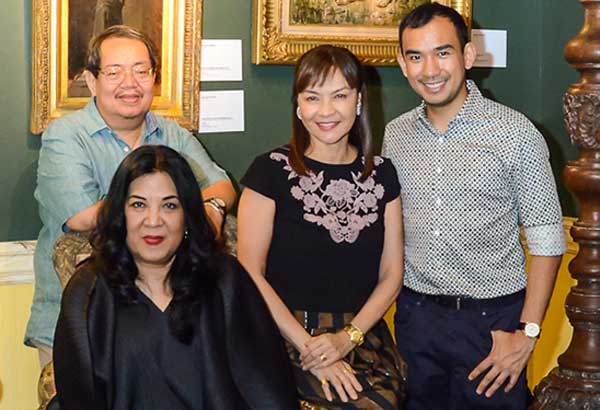Revisiting the glory days of Philippine Art Gallery


Ramon Villegas (standing, left), who sadly met his demise, and Lisa Guerrero Nakpil (seated, left) wanted to shine a spotlight on the contributions of the PAG in the exhibition “Mid-Century Moderns” at Leon Gallery opening tomorrow. In the photo, they are joined by Tats Manahan (fellow curator of the previous show, “The Gilded Age”) and Jaime Ponce de Leon, director of Leon Gallery.
The Philippine art world is as robust as it is now because of the network of galleries spread all over Metro Manila and other major cities, churning out shows one after another, providing spaces for both emerging talents and established masters. While it is easy to simply chalk it up to the zeitgeist, this thirst for contemporary Filipino art, all of this must have started somewhere. It pays to trace the genesis of the art world to the Philippine Art Gallery (PAG), the first modern gallery in the country founded by Lyd Arguilla in 1950.
Celebrating the importance of the PAG in our history is the show “Mid-Century Moderns: Important Modernist Painting from the Philippine Art Gallery” which opens tomorrow (Aug. 29) at Leon Gallery in Makati City. Curated by Lisa Guerrero Nakpil and Ramon N. Villegas (who sadly passed away during the course of planning for the exhibition), the show shines a spotlight on the contributions of this venerable institution that pivoted Philippine art towards the stream of modernism.
PAG, says Nakpil, contributed to the artistic reconstruction of Manila after it was leveled by World War II. “People at the time were surrounded by death and destruction,” she says. “The artists felt that they wanted to revoke Fernando Amorsolo’s imaginary place. ‘How can you paint like that when we are surrounded by this?’”
These artists would soon organize and call themselves the Neo-Realists. “The PAG,” wrote Purita Kalaw-Ledesma in her seminal book, The Struggle for Philippine Art, “gave birth to the neo-realists, who tended to be exclusive and intellectually superior. Like the countries in the United States and in France, they communicated only with themselves (although, in this case, it could be argued that their banding together was a defense mechanism, a development made necessary by the criticism and lack of understanding of their many detractors).”
The Neo-Realists, of course, would eventually dominate the art scene, some of them becoming National Artists. Hernando Ocampo, Cesar Legaspi, Victor Oteyza, Vicente Manansala, Nena Saguil, Arturo Luz, and Fernando Zobel, among others, showed their works (most of them for the first time) at the PAG. Together with writers, intellectuals, and academicians, the artists would regularly meet at the gallery to talk about the state and future of Philippine art.
At “Mid-Century Moderns,” we are introduced to some of the works exhibited at the PAG during the ’50s, at the height of artistic ferment. “The nucleus for the show,” says Jaime Ponce de Leon, director of Leon Gallery, “was the discovery of the impressive materials consigned by the estate of Anthony Stoner, which were all acquired from the PAG. Tony Stoner was an architect who arrived in Manila with his wife in the 1950s and stayed for the better part of 20 years.”
Another piece in the show is an early Arturo Luz also acquired from the PAG, also in the ’50, by Madame Schneidman, who was “a sculptor who did a joint-exhibition with Fernando Zobel in 1957, where he subsequently introduced her to various important Filipino artists.”
“In this untitled work of a gray chair,” writes Nakpil, “Luz has painted a secret portrait of himself. The chair he has selected is one of those fairly rattan chairs of the period — here, he gives a nod to Van Gogh’s chair, sharing that his own tastes are simple, almost austere…On the chair, instead of Gauguin’s candle, is a bottle of wine, perhaps an allusion to Luz’s taste for the finer things in life. As wine is an acquired taste of the European, the wicker chair is all-Filipino.”
Another important work from the show is Cenon Rivera’s “Mother and Child.” Rivera was introduced by his friend Romeo Tabuena to Lyd Arguilla, who promptly gave him his first one-man show in October 1956. “Mother and Child,” as the news clippings during that time revealed, was part of that exhibition. Depicting a woman garbed in terno, the work features “glorious golds and earthy browns (that) convey both the simplicity and pure joy of the moment.”
Arguably a high point in the history of PAG was the exhibition of Fernando Zobel’s initial foray into his “Saeta” (“Arrow”) series. The show, “Zobel: An Exhibition of New Paintings,” laid the groundwork for his abstract language that he would develop and refine into his energetic, coruscating rhapsodies: the hallmark and highlight of his career.
The Stoner collection and the Schneidman Arturo Luz will herald and be a part of “The Magnificent September Auction,” slated on Sept. 9 also at Leon Gallery. Showcasing a total of 171 lots, the auction also features much-coveted pieces by Fernando Amorsolo, Anita Magsaysay-Ho, Vicente Manansala, and Jose John Santos III, among many others. More than half-a-century later, the PAG pieces are still circulating and finding new collectors.
* * *
Leon Gallery is at Eurovilla I, Legaspi St. cor. Rufino St. Legaspi Village, Makati City.



















